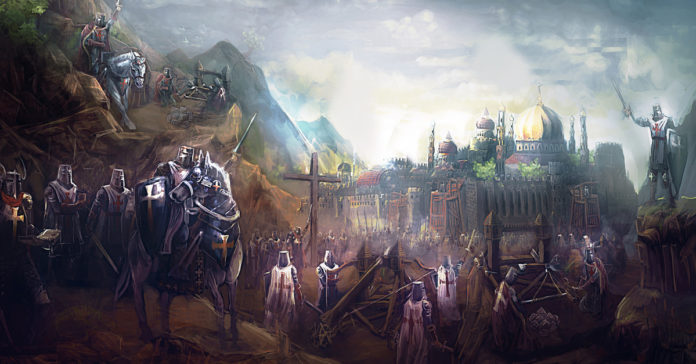The bloody fall of Jerusalem to the Christian Crusaders on July 15, 1099 was one of the darkest days in Islamic history.
The culmination of the First Crusade, the conquest of Jerusalem was characterised by wanton killing and destruction which was readily admitted by those who fought on the Christian side, as an eyewitness described:
“Now that our men had possession of the walls and the towers wonderful sights were to be seen. Some of our men cut off the heads of our enemies, others shot them with arrows, others tortured them longer by casting them into the flames.
“Piles of heads, hands and feet were to be seen in the streets of the city. It was necessary to pick one’s way over the bodies of men and horses.
“But these were small matters compared to what happened at the Temple of Solomon, where men rode in blood up to their knees and bridal reins. Indeed it was a just and splendid judgement of God that this place should be filled with the blood of the unbelievers since it had suffered so long from their blasphemies.”
The First Crusade
In 1095 Pope Urban II called for a religious and military campaign to retake Jerusalem from the Saracens (Muslims).
Subscribe to our newsletter and stay updated on the latest news and updates from around the Muslim world!
The reasons behind the Crusade were complex but among them were religious fervour; the desire to come to the aid of Christian pilgrims who were allegedly being persecuted; territorial expansion; and the need to send troublesome Christian knights on a foreign mission.
The Pope promised those who volunteered for the Crusade salvation in the hereafter and the prospect of riches in this life.
He said: “Let those who have been accustomed unjustly to wage private war against the faithful now go against the infidels and end with victory this war which should have been begun long ago.
“Let those who for a time have been robbers now become knights. Let those who have been fighting against their brothers and relatives now fight in a proper way against the barbarians. Let those who have been serving as mercenaries for small pay now obtain the eternal reward.”
Widespread ignorance
The Christians were largely ignorant about Islam and believed that Muslims worshipped Muhammad. And their hatred had been stoked by fierce fighting against Muslims which had already been taking place in modern day Spain.
Meanwhile, the Muslims saw the Crusaders as crude and ignorant savages with an inferior culture to their own.
When the Muslims captured Jerusalem in 637 they allowed Jews to return to the city (they had been banished in 136 by the Roman Emperor Hadrian), and there had been a generally high degree of religious tolerance under Muslim leadership. Christians, for example, were allowed to visit their holy sites.

But as the First Crusade was launched the Muslim world was divided – Jerusalem was controlled by the Seljuks but the Shia Fatimids, whose Caliphate was based in Cairo, took it back in 1098.
Because of these divisions, as the Crusaders advanced in the Middle East they were sometimes even welcomed by Muslims who allied with them against their fellow Muslim enemies.
The Crusaders had set out from Europe with 5,000 knights and 30,000 footsoldiers, most Frenchmen, and as they advanced they murdered and pillaged, killing lots of Jews, especially. Nevertheless they attracted greater numbers, mostly peasants and mobs.
In fact, so unruly was their behaviour that when they arrived in Constantinople the Orthodox Christian Byzantine Emperor swiftly moved them on.
By now the Fatimid governor of Jerusalem was expecting an attack and had expelled Orthodox Christians in preparation to defend the city.
But he would have to wait because the Crusaders were delayed by the siege of Antioch which lasted eight months before then resting for a further six months, before finally launching their attack on Jerusalem.
Slaughter and carnage
On June 7, 1099 12,000 Crusaders first saw Jerusalem. They then embarked upon a relatively short siege of one month and decided to attack early because of a shortage of water.
They built siege towers to attack the city’s walls with the final assault coming on July 14. A great slaughter ensued and the city was looted. The carnage was awful as Jews and Muslims were put to the sword. The city’s Christians were only spared because they had already been expelled.
A great stench hung over the city for days with possibly 10,000 dead. The historian Ibn Athir said: “It was discord between the Muslim princes that enabled the Franks to overrun the country.”
The Crusaders would hold onto Jerusalem for nearly 90 years before the great Muslim leader Salahuddin al-Ayyubi took it back in 1187. In contrast to the Crusader carnage the Muslim general would show mercy to those he conquered.












![The Taliban’s Road To Success [Short Film]](https://5pillarsuk.com/wp-content/uploads/2024/11/Kabul-roadworks-thumbnail-218x150.png)









